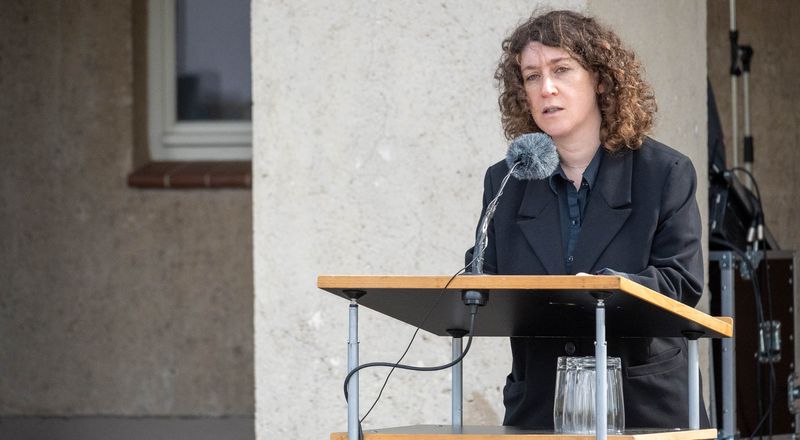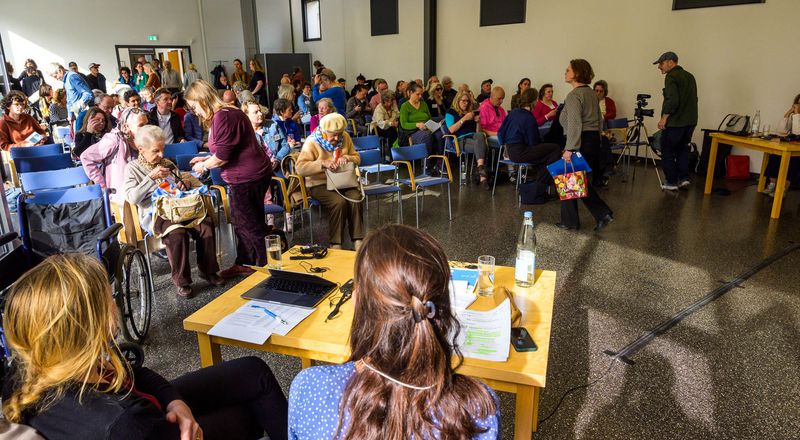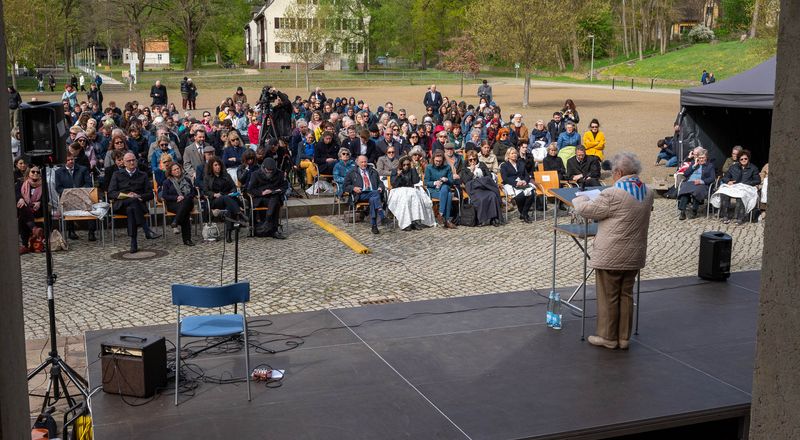Impressions of the 79th Anniversary of Liberation, April 2025
8 Images
Photos: Eberhard Schorr.
From 11 to 14 April 2024, the Ravensbrück Memorial, together with the International Ravensbrück Committee (IRK), commemorated the 79th anniversary of the liberation of the Ravensbrück women's concentration camp with a series of events. More than 500 guests from Germany and abroad took part in the celebrations, including eight survivors from Denmark, Germany, France, Great Britain, Israel and Poland.
Commemorative Event on 14 April 2024
The central commemoration ceremony took place on Sunday, 14 April 2024, at 10 a.m. In his welcoming address, Minister President Dietmar Woidke paid tribute to the victims and called for tolerance, humanity and a resolute stand against hatred, racism and anti-Semitism. Andrea Genest, Director of the memorial site, and Ambra Laurenzi, President of the IRK, opened the event.
Barbara Piotrowska, who was deported to Ravensbrück with her mother after the Warsaw Uprising in October 1944, and Richard Fagot, who was taken to Ravensbrück concentration camp with his mother in November 1944 at the age of nine and liberated in Sachsenhausen concentration camp in April 1945, spoke about their experiences in Ravensbrück and drew direct links to current conflicts in their speeches. Barbara Piotrowska expressed her solidarity with the victims of the Russian war of aggression in Ukraine.
In his speech, Richard Fagot emphasised that his family's survival was an extraordinary stroke of luck and that he had vowed together with them: ‘Never again!’ This vow, he explained, was not just personal, but a collective promise.He drew parallels to the present day and described the recent Hamas attacks on Israel and the global reactions to them.He criticised the spread of false information on social media, which turns victims into perpetrators, and warned of the resulting dangers for the future.
He concluded by appealing to those present to remain vigilant, critical and honest in order to prevent a repeat of the crimes committed 80 years ago.
The author and journalist Lena Gorelik said with regard to all people today who are ‘affected by racism, by hostility towards Muslims, who look different, believe differently, love differently, whose bodies are different’: ‘I am standing here in 2024, and I know that the fears that these people have are not new. They are the same fears that the women of Ravensbrück could tell you about. The fears are not new, and the fact that they are not new makes them even greater. It makes them more real because we can remember, we didn't have the opportunity to forget, to put the past behind us, to have closure with the past.’
The event ended with wreath-laying ceremonies at the ‘Die Tragende’ memorial and the symbolic laying of roses in Lake Schwedt to commemorate the many victims who were murdered at this site.
Further highlights of the memorial weekend
On Saturday, 13 April 2024, the exhibition ‘But I live’ was officially opened. The exhibition presents the life stories of four Holocaust survivors who suffered the horrors of the concentration camps as children. The graphic novel by Barbara Yelin about Emmie Arbel, who survived the Ravensbrück concentration camp, was at the centre of the adaptation of the exhibition. Emmie Arbel herself travelled from Israel to take part in the opening.
On Thursday, 11 April 2024, a book launch with Barbara Yelin and Emmie Arbel took place at the Rosa-Luxemburg-Stiftung in Berlin, which provided a moving prelude to the commemorative programme.
Another key event was the ‘International Forum of the 2nd and 3rd Generation’, which took place on Saturday, 13 April 2024, for the first time since 2019. More than 50 children, grandchildren and great-grandchildren of former prisoners took the opportunity to exchange ideas and network. The forum ended with a public panel discussion that addressed questions of remembrance culture and intergenerational responsibility.
Background
Between 1939 and 1945, over 120,000 women, 20,000 men and around 1,000 young people from the ‘Uckermark youth protection camp’ were imprisoned in Ravensbrück concentration camp. Tens of thousands died of hunger, illness, violence or were murdered. At the beginning of 1945, around 6,000 prisoners were murdered in the newly built gas chamber. At the end of April 1945, the SS drove tens of thousands of prisoners on death marches, while 3,000 sick people in the main camp were liberated by the Red Army.








